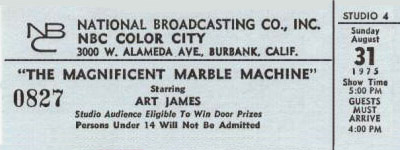Magnificent Marble Machine, The


Pinball was big in 1975 but someone at the NBC and the game show company Heatter-Quigley didn’t seem to grasp that people liked to play it, not to watch it. In fact, it’s frustrating watching someone else do something like that because you keep thinking when you’d push the button and every time they miss, you want to elbow them aside and take over.
People also liked the new, high-tech pinball machines that were coming out and had very little interest in a huge, clunky lower-tech one called The Magnificent Marble Machine. Also, of course, the folks who were flocking to arcades to play pinball were not the housewives who had to tune in if a game show was going to be successful. So right there, you had more than enough reasons for this one to be a fast flop. Which it was.
It went on NBC in July of that year with Art James as the host and by December, the big pinball machine was in storage. Mr. James was a very good, fast-on-his-feet master of ceremonies who had hosted two modest successes in the game show field — Say When and The Who, What or Where Game. But between and after them, he had the misfortune to get hired for a string of less-than-classics. They included Blank Check, Catch Phrase, Fractured Phrases, Pick and Choose, The Shopping Game, Temptation and Pay Cards. After several in a row failed quickly, he stopped getting called for emcee jobs and returned to his previous station as a game show announcer. Not long before he retired, he had a role in Kevin Smith’s movie, Mallrats, playing — you guessed it — a game show host.
The Magnificent Marble Machine involved two teams (each with one celebrity and one civilian) competing in a question round and then the winning team got to play the big pinball machine. The question round was a bore: Clues were displayed on a screen and players had to buzz in and identify what they were describing. But the pinball machine wasn’t much more exciting. It was twenty feet high and twelve feet wide and the two players on the team had to work the flippers, keep a large ball in play and try to light up bumpers. The more bumpers that were lit up, the bigger the contestant’s winnings. But the flippers didn’t flip so well and it often felt like someone was losing out on the big money because Adrienne Barbeau couldn’t make work the controls properly.
I visited the set one time when my friends, Charlie Brill and Mitzi McCall, were the celebs. They struggled in a pre-taping practice session to learn how to make the flippers flip…but by taping time, they’d both failed to light up one bumper. “I hope nobody’s planning on winning anything today,” Charlie quipped. When they started playing for real, it almost went that way. I remember standing next to the machine during a break and having a great urge to play it, which the crew wouldn’t let me do because then they’d have to let everyone on the set play with it. Everyone wanted to…but like all of America, we had no interest in watching somebody else play it.
By the way: I like that line on the tickets that says, “Studio audience eligible to win door prizes.” Note that it doesn’t actually say that there are door prizes or that someone who attends a taping will win one. It just says that if you’re there, you’re eligible for any door prizes that might occur. The folks who played that day with Charlie and Mitzi were eligible to win things too and didn’t.






